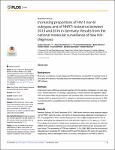Increasing proportions of HIV-1 non-B subtypes and of NNRTI resistance between 2013 and 2016 in Germany: Results from the national molecular surveillance of new HIV-diagnoses
Hauser, Andrea
Hofmann, Alexandra
Meixenberger, Karolin
Altmann, Britta
Hanke, Kirsten
Bremer, Viviane
Bartmeyer, Barbara
Bannert, Norbert
Background
Molecular surveillance of newly diagnosed HIV-infections is important for tracking trends in circulating HIV-variants, including those with transmitted drug resistances (TDR) to sustain ART efficacy.
Methods
Dried serum spots (DSS) are received together with the statutory notification of a new diagnosis. 'Recent infections' (<155 days) classified by a 'recent infection test algorithm' (BED-CEIA and clinical data) are genotyped in HIV-protease (PR), reverse transcriptase (RT) and integrase (INT) to determine the HIV-1 subtype, to calculate prevalence and trends of TDR, to predict baseline susceptibility and to identify potential transmission clusters for resistant variants.
Results
Between January 2013 and December 2016, 1,885 recent infections were analysed regarding the PR/RT genomic region, with 43.5% of these also being subjected to the analysis of INT. The proportion of HIV-1 non-B viruses (31.3%; 591/1,885) increased from 21.6% to 36.0%, particularly the subtypes A (5.0% to 8.3%) and C (3.2% to 7.7%; all ptrends < 0.01). The subtype A increment is mainly due to transmissions within men who have sex with men (MSM) while subtype C transmissions are associated with heterosexuals and people who inject drugs. The prevalence of TDR was stable at 11.0% (208/1,885) over the study period. Resistances to nucleotide RT inhibitors (NRTI) and PR inhibitors (PI) were 4.5% and 3.2%, respectively, without identifiable trends. In contrast, resistances to non-NRTIs (NNRTI, 4.7%) doubled between 2014 and 2016 from 3.2% to 6.4% (ptrend = 0.02) mainly due to the K103N mutation (from 1.7% to 4.1%; ptrend = 0.03) predominantly detected in recently infected German MSM not linked to transmission clusters. Transmitted INSTI mutations were present in only one case (T66I) and resistance to dolutegravir was not identified at all. Reduced susceptibility to recommended first-line therapies was low with 1.0% for PIs, 1.3% for NRTIs and 0.7% for INSTIs, but high for the NNRTIs efavirence (4.9%) and rilpivirine (6.0%) due to the K103N mutation and the polymorphic mutation E138A. These trends in therapy-naïve individuals impact current first-line regimens and require awareness and vigilant surveillance.

